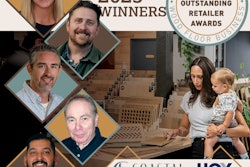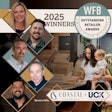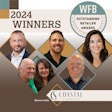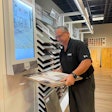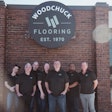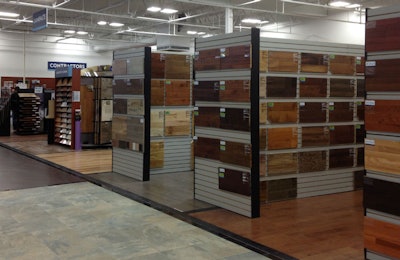
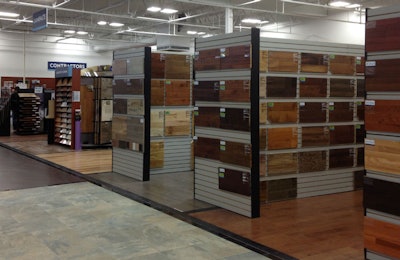
Avalon FlooringLocation: Cherry Hill, N.J. |
WFB's Andrew Averill spoke with Sean O'Rourke, the vice president of hard surfaces at Avalon Flooring in Cherry Hill, N.J. He's been with Avalon for 26 years.
Describe your operations.
We have 14 locations—eight in New Jersey, five in Pennsylvania and one in Delaware. I would say the retail business is as much as 50–60 percent of our business. Then you have the builder business, contractor business and Main Street commercial. But as far as percentages, retail is number one, then builder, then contractor and then Main Street. We're what you call a full-service flooring retailer. We supply and install everything we sell.
What percent is hardwood flooring?
 Sean O'Rourke, VP of Hard Surfaces
Sean O'Rourke, VP of Hard Surfaces
Hardwood represents about 17 percent of our total business breakdown. Tile and stone is more than 40 percent of the business. That gives you some perspective. We do provide unfinished product for some builders and contractors whenever they need it, but for the most part we are not in the unfinished business.
Has that always been the case?
We tried to dabble in it in the late 2000s, and we just figured out it wasn't our business. Of our hardwood business, 99.9 percent is in the prefinished category.
Is that because prefinished sells easily or because unfinished has extra variables?
The latter. It's a separate business entity. It's more hands-on. It's just not something we're really structurally set up to handle. Typically, the way I see the unfinished business in our area, it is very contractor-driven.
What are the most significant changes in the retail business over the past three decades?
Prefinished wood flooring 20–25 years ago was the new kid on the block, and new construction was dominated by the unfinished people. Over the last 20 years, not only has prefinished gotten total acceptance from the retail customer, but it has also gained builder acceptance. That's probably the biggest change. There are fewer and fewer builders who want or ask for job-site finished wood.
Has Avalon always been ahead of these changes?
I don't think we've ever fallen behind as far as the changes in the market. Where we're located, you have a high concentration of distributors, so we've always been front-and-center as far as new product development, but we've certainly had to change quite a bit over the last few years. When I started with Avalon, Home Depot, Lowe's and Lumber Liquidators didn't even exist, so your competition was basically the sand-on-site guys and some of the hardwood or lumber distributors who were selling unfinished and then started selling prefinished. To compete, we've had to adjust our product mix. We're typically not going after that low-end customer that the box stores are.
How did you change your product mix?
Four years ago, we went from showing manufacturer display products to a 100 percent private-label system. By changing to the private-label model, it allowed us to take charge of what we sampled on the floor, how we priced it, etc. We followed the 80-20 rule: You may have a display rack on your floor with 100 samples, but you look at your sales 12 months later and probably only 20 of those samples really ever generated any sales. We took what we felt to be the best sellers of some of the big manufacturers and private-labeled them. We went to two uniform sample sizes—24-by-12 inches for the more generic products and larger 24-by-24-inch samples for the more unique products. The uniform sample size and being able to pick and choose what we put on our floor gave us a product offering that suited our customers, not necessarily the customer mix for 48 states. And by private-labeling products, it allowed us to hang on to more gross profit or margin than you normally would if your customers were able to shop prices at five other retailers for the same product.
Was private labeling a tough sell?
In the beginning there was a certain trepidation as to how this was going to work. Were customers going to accept it? Were salespeople going to accept it? But within a couple months it was absolutely amazing how quickly the "doubters" went away and customers absolutely accepted it. Think of almost any major retailer today, whether it's a food market or Macy's or Target, they all have their own private label product.
What are some mistakes retailers make?
A lot of retailers try to jam their showroom floor with too many display racks, and they don't leave enough space to make it easy for a customer to make a decision. They have too much of the same type of products. Another big one—for smaller retailers especially—is they don't set margin goals. They basically price material and jobs on the fly based on what their workload will allow or how their business is for that week or month. Most professional businesses work on a cost structure driven by a percentage overhead, and you need to deliver X amount of sales and generate a certain amount of profit. If you're not working with those guidelines, you'll think you're going to take a job and make $2,000, but you've only made a 10 percent margin on it, and your underlying costs are probably going to be way higher than that. That makes it difficult for small retailers to survive and grow their business. These mom-and-pop flooring stores may be around for 30–40 years, but it may be very difficult to pass that business on to their families without guidelines in place for the next generation to follow.
How do you keep improving a retail business?
One thing we've done is hire consultants to analyze our processes from the minute a customer walks in the door to when the product is installed. We tried to look at every touch-point that a customer has with different people in our organization, whether it's the front desk, sales person, in-house estimator, the installation department or the actual installer. We try to make sure we have a very uniform experience from start to finish.
What did the consultants find?
Customers are looking for consistency. Keeping the communication channel open and making sure the customer knows with whom they're supposed to be in contact with is very important. We don't want the customer contacting our salesperson on the day of the installation, because the install department will know what's going on that day. Customers also told us they don't want to be put on hold and then be told someone will get back to them.
RELATED: How Hiring Outside Experts Transformed Our Wood Flooring Business
Do you do training?
Yes, we've had professional sales training people come in and do two-day classes. We also have the buddy system.
What's the buddy system?
To get good at selling, whether it's one product or 10, you need reinforcement and continued training. For their first six months, we have new hires tail somebody who has been around a while. We typically try to move them between two or three people, because maybe an experienced salesperson might have a penchant for selling ceramic tile, but we need to make sure the person is exposed to other parts of the business. It can take six months to a year to get a new salesperson up to speed. We find that, of all the systems we've tried, the buddy system is still one of the best.
What do you say to people who don't want to invest in employees for fear they'll leave?
That's a risk you take with any business today. You need to make sure that, whether it's benefits or compensation, they don't want to leave. We find once we get people through the first year, we have a very high retention rate, which means getting people up to a level where they can be proficient on the floor and make more money. Not every candidate is going to be right for the flooring business. We try to closely monitor their progress. If we don't think they're going to be right, we have to let them go or move them into a different position.
How do you track their development?
We have our salespeople make a computer entry of almost every customer they interact with. The No. 1 metric is sales, but that's not the whole picture. The other thing we look at is the close ratio and the number of estimates the salespeople are generating. We're able to look at how many people they're interacting with and what percentage of those customers ultimately are being closed.
What's on the horizon?
Certainly one of the big trends happening now for a while is that product is getting wider, longer, more rustic. In order to represent these products well, because they're bigger, longer and wider, you literally need more space to sample these products. There's a big difference trying to sell a 3¼ inch oak versus 8-inch hickory. How do you adequately show enough product and show it well enough so the customer understands what they're purchasing? The other big one is there are lots of competing floor products for wood flooring. If you take wood as a style, you can get it in ceramic tile, LVT, WPC, etc. That's the biggest challenge the wood flooring business has today. If you put six wood-style products in a blind touch test, it's difficult, even for people like myself sometimes, to tell what product it is. One time we used to say a wood customer was always a wood customer, but that's absolutely not true today.
















